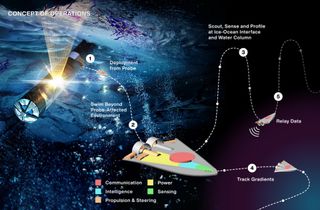Swarms of tiny robots may one day explore oceans on other worlds
A distributed network of robots offers unique advantages.

NASA's Jet Propulsion Laboratory has awarded $600,000 of additional funding towards a concept that would see swarms of diminutive swimming robots sent to explore oceans on moons or planets throughout the solar system.
Such a system of distributed tiny robots could extend the reach of a mission sent to study oceans beneath the icy surfaces of some of our solar system's moons such as Saturn's Enceladus or Jupiter's Europa. The concept, called "Sensing With Independent Micro-Swimmers," or SWIM, is the brainchild of Ethan Schaler, a robotics mechanical engineer at NASA's Jet Propulsion Laboratory in Southern California. The latest funding award was announced in a Jet Propulsion Laboratory news release.
"My idea is, where can we take miniaturized robotics and apply them in interesting new ways for exploring our solar system?" Schaler said in the statement. "With a swarm of small swimming robots, we are able to explore a much larger volume of ocean water and improve our measurements by having multiple robots collecting data in the same area."
While sending robotic explorers to other planets and moons is not a new idea, the SWIM concept would use robots that are much smaller than those typically proposed. The SWIM robots would measure just five inches (12 centimeters) in length and take up only around 3 to 5 cubic inches (60 to 75 cubic centimeters) in volume. Each robot would contain its own onboard computer, propulsion system, an ultrasound communication system, and various sensors to measure temperature, acidity, pressure, or other variables. The new funding JPL awarded the SWIM concept will help work towards including chemical sensors that might be able to detect biomarkers in the seas around them.
Schaler envisions dozens of these fitting inside a single robotic "cryobot" that could penetrate a moon's or planet's ice caps in order to reach any seas below. Deploying dozens of the tiny robots could greatly expand the geographical reach of a mission to Europa or Enceladus or any other body on which seas or oceans are found.
Related: Europa: Facts About Jupiter's Icy Moon and Its Ocean
"What if, after all those years it took to get into an ocean, you come through the ice shell in the wrong place? What if there's signs of life over there but not where you entered the ocean?" added SWIM team scientist Samuel Howell of JPL. "By bringing these swarms of robots with us, we'd be able to look 'over there' to explore much more of our environment than a single cryobot would allow."
Get the Space.com Newsletter
Breaking space news, the latest updates on rocket launches, skywatching events and more!
In addition, a distributed swarm of sensor-laden robots would be able to overlap their measurements, thus reducing potential errors. More data points also means greater ability to detect gradients or variances in the swimmers' environment.
The micro-swimmers concept remains hypothetical and is not currently being eyed for any specific NASA mission. However, NASA is currently working towards a 2024 launch for its Europa Clipper mission which will circle Europa dozens of times to study the moon. It's possible the data obtained from Europa Clipper could inform a future mission that includes tiny SWIM robots to finally take a dive into the subsurface oceans under the moon's icy surface.
Email Brett at BTingley@Space.com or follow Brett on Twitter at @bretttingley. Follow us on Twitter @Spacedotcom or on Facebook.
Join our Space Forums to keep talking space on the latest missions, night sky and more! And if you have a news tip, correction or comment, let us know at: community@space.com.

Brett is curious about emerging aerospace technologies, alternative launch concepts, military space developments and uncrewed aircraft systems. Brett's work has appeared on Scientific American, The War Zone, Popular Science, the History Channel, Science Discovery and more. Brett has English degrees from Clemson University and the University of North Carolina at Charlotte. In his free time, Brett enjoys skywatching throughout the dark skies of the Appalachian mountains.
